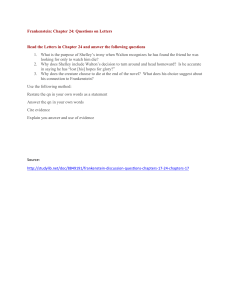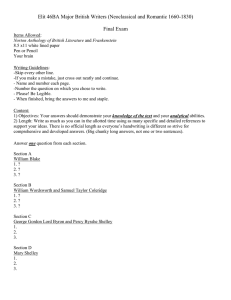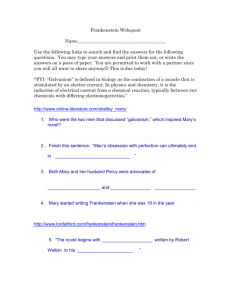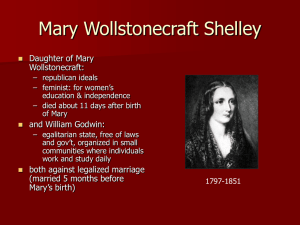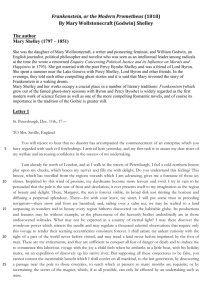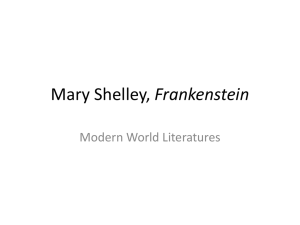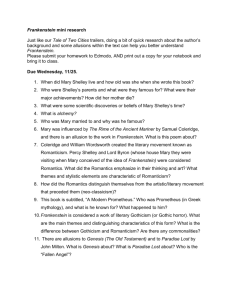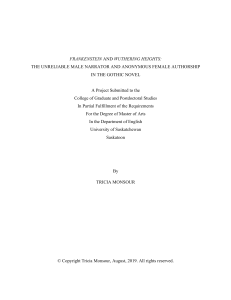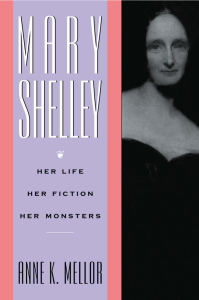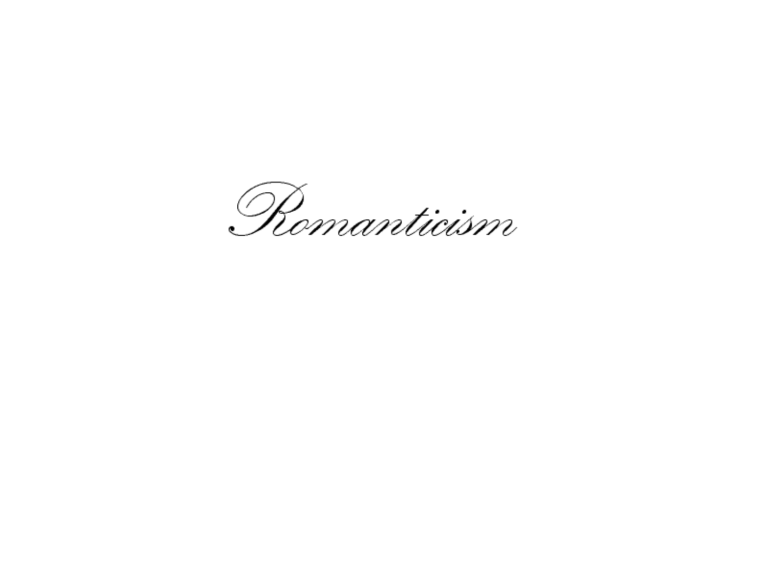
Characteristics of ROMANTICISM 1. Fascination by the unknown - mystery - power of evil, struggle against evil & mystical powers - Frankenstein Fascinated by long ago and far away - heroic – “Aida” Mary Wollstonecraft Shelley (1797-1851) When Mary is sixteen she meets the young poet Percy Bysshe Shelley, a devotee of her father's teachings. Together with Mary's stepsister, they run off to continental Europe several times, not hindered by the fact that Shelley was already married. In 1816, they go abroad again, this time spending time with Byron and his friend Polidori in Geneva. There Byron suggests that they should all write a ghost story. Mary writes Frankenstein, the only story of the four that was ever to be published as a novel. Later that same year, Percy's wife drowns herself: Percy and Mary marry in December 1816. 1820 – Ampere wrote “Laws of the Electrodynamic Action” 1821 – Faraday discovers fundamentals of electromagnetic rotation Wheatstone demonstrates sound reproduction Referred to by Mary Shelley: •Paracelsus (aka Theophrastus Bombastus von Hohenheim) (1493-1541) Paracelsus was a German physician and chemist who claimed diseases are caused by agents that were external to the body and that they could be countered by chemical substances. He defied the belief of the so-called Scolastics, that diseases were caused by an imbalance of bodily "humors" or fluids, and that they would be cured by bloodletting and purging. “She has replaced the heavenly fire of the Prometheus myth with the spark of newly discovered electricity. The concepts of electricity and warmth led to the discovery of the galvanisation process, which was said to be the key to the animation of life. Indeed, it is this process which animates Frankenstein's monster.” http://home-1.worldonline.nl/~hamberg/ For good reason, the novelist chose not to begin her story with the chilling event of the dreary night in November. Who, in 1818, would have read such an improbable story? Instead of the major event, the book opens with a series of letters from Robert Walton, a self-educated Englishman dedicated to scientific exploration. He has embarked upon the icy northern seas to view" a part of the world never before visited, and ...tread a land never before imprinted by the foot of man" (Letters, I, 116). Obsessed with training himself for his self-appointed task, Walton studied navigation, mathematics, and the science of medicine. His devotion to study separated him from others. Despite his zeal for the voyage of discovery, Walton recognized his isolation and shared his desire for a congenial equal in self-explanatory, informative letters to his sister in England, Margaret Saville. As he travels, Walton envisions himself discovering the cause for magnetic north in the land where the sun never sets. Walton reflects the contemporary interest in scientific expeditions: welleducated men chose to explore the unknown and expand mankind's knowledge of the universe. He represents a reasonable person who properly prepared both for the hardships of the trip and the possible needs of a journey into the unknown. The rational man provides a reassuring narrator, one who enables the reader to accept the story he tells,… http://ntserver.shc.edu/www/Scholar/neal/neal.html Return to classics & exoticism 2. Emotion and imagination over logic and intellect Resentment of rules and restraints cherished freedom The importance of the individual Education is important, but not just Learning facts… discovery…investgation The German romantic painter Caspar David Friedrich, b. Sept. 5, 1774, d. May 7, 1840, was one of the greatest exponents in European art of the symbolic landscape. Wanderer above the Sea of Fog The Cross on the Mountain 4. "The noble savage" – civilization corrupts people, nature is a healer - Wordsworth & Thoreau Enthralled by nature - the world untainted by human beings James Fenimore Cooper. The Last of the Mohicans (1826). Tarzan of the Apes By Edgar Rice Burroughs 1912 From “The Ghost Pirates” - By William Hope Hodgson (1875-1918). 5. Artists studied other arts and dabbled in them - the unity of the arts - love of beauty 6. An artistic work reflects the artist art as expression - introspection/selfcenteredness Therefore artists could be nonsocial or even antisocial Delacroix, Eugène, (b. April 26, 1798,.--d. Aug. 13, 1863, Paris), the greatest French Romantic painter, whose use of color was influential in the development of both Impressionist and Postimpressionist painters. His inspiration came chiefly from historical or contemporary events or literature, and a visit to Morocco in 1832 provided him with further exotic subjects. The Sea of Galilee Romanticism implies fantasy, spontan and sensitivity. Books by Jules Verne (1828-1905) 1863 - Five Weeks in a Balloon 1864 - A Journey to the Center of the Earth 1866 - From the Earth to the Moon 1870 - Twenty Thousand Leagues Under the Sea 1873 - Around the World in Eighty Days 1874 - Mysterious Island 1904 - Master of the World Edgar Allan Poe 1809 - 1849 Sir Arthur Conan Doyle (1849-1930) Nationalism Greeks vs Turks Poland vs Russia Belgium vs the Dutch Italy vs Austria & Spain Internal France Germany
